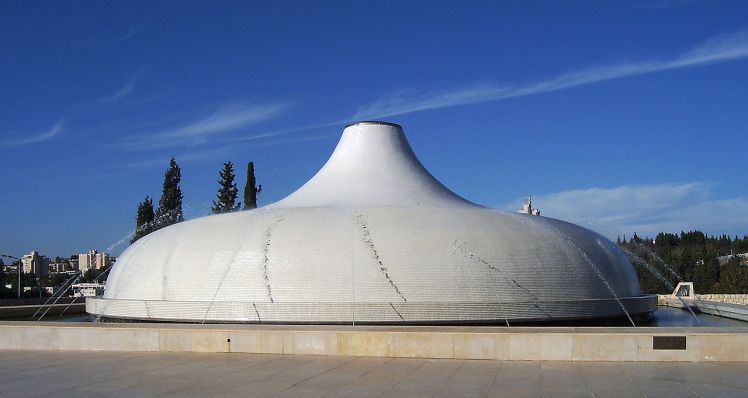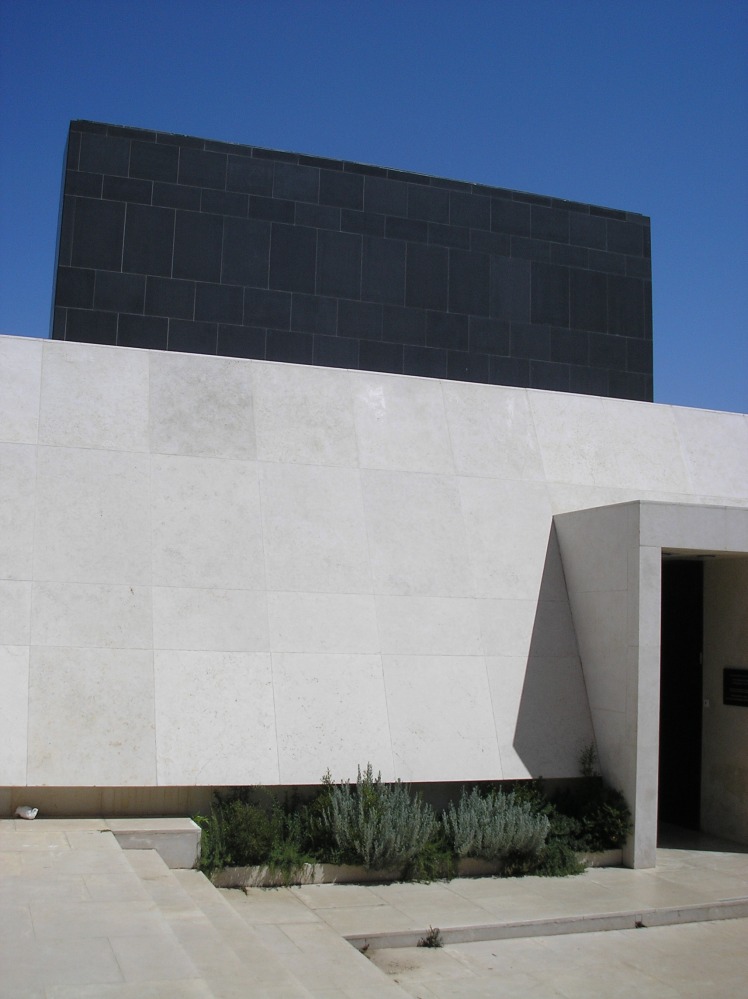The worst part about getting my phone stolen is being unable to share the photos that I took today during my walk through the Rehavia Park Valley of the Cross and at the Israel Museum. You’ll just have to accept the reproducible photos that I found online.
I’ve actually never gone to a museum by myself, so it was pretty neat having the freedom to go through the exhibits at my own pace. Rather than try and cover every inch (or centimeter) of the museum, I chose to delve into only a few exhibits.
Shrine of the Book
My first stop was the Shrine of the Book, which houses the Dead Sea Scrolls. There are tons of pictures online of the white dome, which is supposed to resemble the tops of the jars that originally housed the scrolls.

Less commonly photographed is the black basalt wall facing the Shrine of the Book. Unfortunately, this was the best photo I could find that allows for reproduction.

Having the two structures next to each other symbolizes the tension between the Sons of Light (white dome) and the Sons of Darkness (black wall). The water spraying onto the white dome symbolizes the purity of the sectarians.
My ticket to the Israel Museum included a free audio guide, so I took the liberty of listening to the segments related to the Shrine of the Book. I thought it was neat how they created an audio “play” that exemplified the different aspects of life for the sectarians (e.g. ritual immersion and purification, pottery-making). Listening to different characters talk about what was going on and how they felt helped paint a clearer picture of what their lives were like.
Art Garden
I usually don’t know what to make of 3D sculptures, but these two pieces seemed really special. I’ve never seen anything quite like them.
At first, I couldn’t figure out what was going on with Micha Ullman’s Equinox, but after listening to the audio guide, I had a greater appreciation for the piece.

It’s a little easier to tell from this video what is happening in this dynamic piece of art. When you look down into the glass, you see a four-sided chamber. One of the sides has an opening into a dark corridor. Based on the direction of the sun shining in, you can see the reflection of a rectangle at different locations inside the chamber. Twice a year, on the spring and autumn equinoxes, the rectangle of light appears opposite the opening of the dark corridor. The audio guide’s interpretation was that on two days of the year, light and dark face each other “in perfect balance.” Pretty sweet description, huh?
Instead of looking down into the sculpture like in Equinox, the audience is forced to look up in James Turrell’s Space That Sees.
I was surprised how peaceful it was inside the sculpture. Apparently, the material was chosen to minimize distractions within and to allow people to explore “the meditative space of mind.” Here is some more beautiful, flowery language from the audio guide: “the eye that looks outward becomes the eye that looks inward.”
Today’s weather was really overcast, so at first, I actually couldn’t tell which part was the white border around the sculpture and which part was the sky. It wasn’t until after taking a picture on my phone (R.I.P. dear phone) and looking closely at the image that I could identify the sky. Fun fact: When I first walked into the room, I actually thought the ceiling was painted white…whoops.
The Shadow of Color
This exhibit featured art from four artists who contributed to the abstract artform: Otto Freundlich, Blinky Palermo, Lygia Clark, and Len Lye.
Otto Freundlich believed strongly in socialism and used his art as a form of propaganda. You’ll notice that each section of his composition has its own character. No one part dominates the others. From the audio guide: “Each piece is important not because they are identical, but because they are equal.” Other than political cartoons, I never really thought much about art being a form of a political manifesto, especially not abstract art.
Blinky Palermo explored physical presence in abstract art. His Composition Red/Orange is actually a canvas painting (horizontal) mounted on a single wooden pole (vertical). He somehow managed to create a painting that could be viewed as a structure with volume, depth, and shadow.
Lygia Clark believed that the viewer should never be passive—not when viewing her art or when living life in general. Her Bichos (critters) structures are essentially pieces of metal hinged together. She didn’t have a “final form” for these structures; rather, she wanted viewers to participate in the process of creating art by reshaping the figures. I thought this was a unique way of encouraging public involvement. I’m not surprised that she eventually dedicated the rest of her life to art therapy.

Len Lye lived in many, many countries throughout his life, which probably contributed to his attraction to movement. A Colour Box (1935) and Free Radicals (1958) were two of his featured pieces. He treated the film like a canvas and placed color directly on the celluloid (no camera needed!). His selection of background music was also spot on.
All in all, I had a fairly productive day. I spent the morning developing my art appreciation and the afternoon/evening learning how to be a grown-up. Time to get some rest.
Reblogged this on Learn for Lyfe and commented:
Appreciating art in Jerusalem
LikeLike
I find it really cool that the Otto guy used abstract art as socialist propaganda! And that you wrote such a detailed reflection 🙂
LikeLiked by 1 person